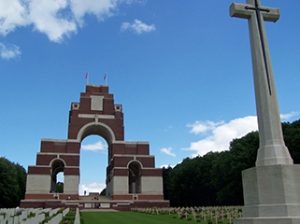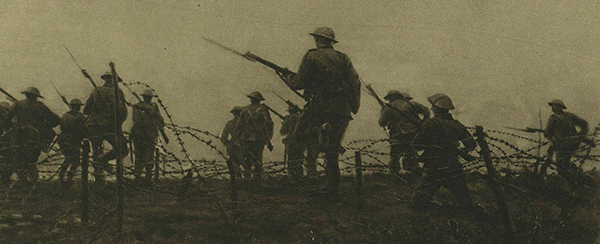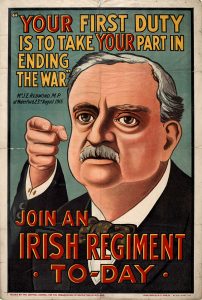The Battle of the Somme on RTÉ
Published in Issue 5 (September/October 2016), Reviews, Volume 24Nationwide, RTÉ1, 29 June, 1 July
Heroes of the Somme, 4 July
The centenary commemoration of the battle of the Somme, 9 July
By John Gibney

Above: The Thiepval Memorial near the towns of Albert and Bapaume, site of a major ceremony held each year on 1 July to commemorate the Battle of the Somme. (Commonwealth War Graves Commission)
The Battle of the Somme, in the Picardy region of northern France, was the British contribution to a wider Allied offensive against the Central Powers in 1916. It lasted 141 days, during which British forces suffered 420,000 casualties, making it the most costly military action in which they participated during the First World War; the French suffered 220,000 casualties, while the Germans suffered as many as 500,000 (and the latter two sets of combatants were also embroiled in the bloodier and even longer Battle of Verdun, south of the Somme offensive). The Somme encapsulates the British experience of the First World War more than any other battle and, given that the Irish experience of direct combat during the war took place within the ranks of the British Army, there was an Irish dimension to this as well. Approximately 3,500 soldiers from the island of Ireland, serving in the 16th (Irish) and 36th (Ulster) Divisions, lost their lives (and this has long had an iconic significance to the unionist tradition).
RTÉ devoted a good deal of attention to the Somme centenary—or, more precisely, to the centenary of its outbreak—though the commemoration of the Somme, despite its enormous human cost, did not register to the same degree as a certain other centenary that was marked earlier in the year. Perhaps it is easier to commemorate an event that lasted six days (such as the Easter Rising) than an event that lasted 141 days. The dramatic image looms large in commemoration. With regard to the international commemoration of the Somme, the image of troops going over the top at 7.30am on 1 July has long been enshrined; this was the date chosen for the major multinational commemoration that took place at the Thiepval Memorial to the Missing (which also incorporated an Irish dimension, in the stories of Thomas Kettle and William McFadzean). RTÉ’s coverage of the dignified yet understandably sombre state commemoration of the Somme at the National War Memorial Gardens at Islandbridge spoke for itself, but was accompanied by informed and informative commentary by Kevin Myers and Philip Orr, both of whom had championed and investigated the subject of the Irish involvement in the war long before it became fashionable. Recent years have seen an enormous public interest in the Irish experience of the war, owing not only to the changed public climate of recent decades but surely also to the fact that one is far more likely to have had an ancestor in the British armed services than in the Irish Citizen Army or the Irish Volunteers.

Above: British troops making their way through barbed wire entanglements. (Illustrated London News, 26 August 1916)
Two episodes of Nationwide also tackled the subject. One, presented by Brian Dobson, provided a basic overview of the campaign and the Irish involvement in it. The other was by far the more intriguing, as it covered a project—originally the brainchild of Gerry Moore, a teacher from Donegal—in which students from around the island of Ireland explored the stories of individual soldiers from their counties of origin; all seemed deeply affected at the human reality of what their subjects had endured. It also revealed the extent to which the Irish experience of the war, which took place away from Irish shores, pervaded the reality of life across the island in the years and decades afterwards, and how much of it remains to be uncovered. We have all heard of Tom Kettle, who died at Ginchy. But what about Charles Francis Conway, from a republican family in Tralee, who joined the Royal Munster Fusiliers and also died there? His memory was quietly hidden within his family, though his niece recalled playing with his medals. This episode was a striking introduction to the complexities of the Irish experience of the Somme as well as of the wider war.
A focus on individual stories, and journeys of discovery, was the approach taken by Heroes of the Somme, a BBC/RTÉ co-production that focused on seven Irish soldiers who won the Victoria Cross in the Somme campaign, such as William McFadzean, a young man from Belfast who joined the 36th (Ulster) Division and was killed even before leaving the trenches after he threw his body on a number of primed grenades in order to save the lives of his comrades. (Three more members of the Ulster Division were awarded the VC on 1 July.) McFadzean has long been an icon in a unionist culture in which war service posed no difficult questions. The same cannot be said of Thomas Hughes of Monaghan, who won the VC for capturing a German machine-gun post and who died in impoverished obscurity; necessity forced his family to sell his medals.

Above: Irish Parliamentary Party leader John Redmond on a 1915 recruiting poster. A year later, after the horrors of Gallipoli, he could still claim that ‘the cause of Ireland . . . was never in worthier, holier keeping than that of these boys, offering up their supreme sacrifice of life with a smile on their lips because it was given for Ireland’.
Institutions such as the Commonwealth War Graves Commission deserve great credit for ensuring that soldiers who fought for the British Empire received a dignified burial and are remembered for posterity. That also provides a salutary warning to those who might appropriate their deaths or attempt to dismiss them. No one could argue about the horrific human cost, but when emphasising the ‘sacrifice’ of the dead of the war it should not be forgotten that this was not a sacrifice of their making. It is extraordinary to think that in 1916 John Redmond provided the introduction to Michael MacDonagh’s book The Irish at the front, in which he assured his readers that the ‘cause of Ireland . . . was never in worthier, holier keeping than that of these boys, offering up their supreme sacrifice of life with a smile on their lips because it was given for Ireland’. Redmond wrote this after the horrors of Gallipoli. How did that seem by the end of 1916? Discussions of ‘shared’ history, in which the Irish experience of the Great War is sometimes located, are redundant in one sense; an accurate rendering of history will always reveal the infinite, and often uncomfortable, grey areas that emerge from the past.
Both episodes of Nationwide will be available on RTÉ Player until 2019, while much of the RTÉ coverage, along with a wide range of essays, reportage video and visual material on the Battle of the Somme, has been collated on the Century Ireland website: http://www.rte.ie/centuryireland/index.php/battle-of-the-somme/.
John Gibney is the author of A history of the Easter Rising in 50 objects (Mercier Press, 2016).
















